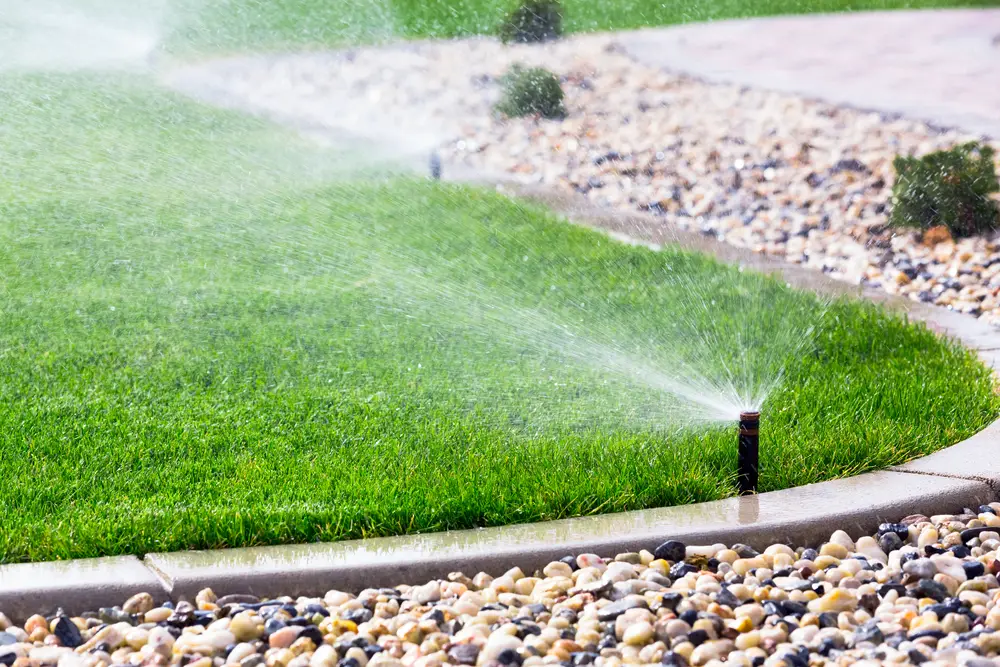Sprinkler systems offer an easy way to distribute water evenly, which can save your yard and keep your plants alive.
If you plan to build a shed or add a few square feet of a concrete slab to your yard and have noticed that your sprinkler lines will go right underneath the slab, you might be contemplating whether or not to proceed with your new project.
In this regard, Can Sprinkler Lines Run Under Concrete?
Yes, running sprinkler lines under concrete is possible altogether. However, the pipes need to be recessed into trenches in the ground because sprinkler lines are more prone to leaking, and even small leaks can significantly damage concrete. Burying the sprinkler lines in trenches also protects them from freezing. Any sprinkler heads that will go under the concrete slab must also be sealed.
A good alternative to running sprinkler lines under concrete is to reroute the pipes so the concrete won’t go over them.
If you plan to lay down an outbuilding or concrete, this post will cover how to run a sprinkler system under concrete safely. It boils down to using the right technique.
How To Run Sprinkler Lines Under Concrete: A 5 Step Process
If you have a reliable sprinkler system that doesn’t have leaking issues, it should be okay to lay concrete over it.
However, you want to ensure no active heads are buried under the concrete, as prolonged water exposure can cause pitting and damage.
Here are steps to safely run sprinkler lines under concrete:
Step 1: Inspect Your Sprinkler System
Before embarking on your project, it is crucial to check your sprinkler system, especially the potion that will run under the concrete.
Ideally, you want to inspect the lines for leaks and check the joints to ensure they are intact.
If there are sections with signs of leaks, don’t hesitate to repair or replace them before doing any work.
On the other hand, if you have had multiple leaks recently and haven’t replaced your system, it makes perfect sense to move it so it won’t go under the slab.
Step 2: Dig Trenches
Water the soil around your sprinkler lines thoroughly to soften the ground, then use your trenching machine to dig the trenches.
You want to make the base of the trenches as smooth as possible and free from stones.
Dig enough trenches to accommodate all the lines, ensuring each trench is 10–12 inches deep. Burying sprinkler pipes below the frost line protects against freezing.
Step 3: Lay The Pipes In The Trenches And Fill The Trenches
Lay your sprinkler pipes in the trench(es), fill the trenches, and compact the soil as much as possible to avoid damage by the concrete.
Leave the trenches undisturbed for two days.
Your sprinkler lines should be well protected, so you can pour the concrete.
Step 4: Prepare The Area Where You Plan To Pour The Concrete
After burying your sprinkler lines, outline the slab location and clear the area of any objects that would interfere with the pouring process.
Ideally, you want to clear everything – trunks, rocks, grass, shrubs, and old concrete – until raw earth is exposed.
It is always advisable to clear about 6 inches beyond the marked area around the perimeter.
Next, build the concrete slab frame (form) and prepare the sub-base, the load-bearing layer.
A 2–4 inches layer of gravel evenly spread over the entire area should be okay. This layer further ensures your sprinkler lines are covered properly.
Step 5: Pour The Concrete
Wear the right safety gear – mask, gloves, safety glasses, pants, and long-sleeved t-shirt and mix the concrete according to the manufacturer’s specifications (one part cement, two parts sand, and four parts gravel are standard).
When the mix is ready, pour it into the form and screed the top while the concrete is still wet until the surface is smooth.
Although your concrete will have hardened enough to be walked on after about 48 hours, let it cure for about 28 days to achieve full strength.
It is important to mist your concrete with a garden hose daily to keep it wet throughout the curing period.
What Are The Potential Issues Of Running A Sprinkler Line Under Concrete?
- When it comes to running sprinkler lines under concrete, the major concern is usually water damage.
- Sprinkler lines are relatively vulnerable to leaking, which can be a threat to concrete slabs and foundations.
- When constantly exposed to water, concrete can suffer pitting (the development of pits on the surface of the concrete) and water damage.
- Along with pitting, prolonged water exposure is also known to cause discoloration.
- The pressure exerted by concrete can also damage sprinkler lines that are not well covered, reducing the efficiency of your sprinkler irrigation system.
However, running a sprinkler line under the concrete does not always amount to damage.
As long as your pipes are in good condition, you lay them deep enough, and seal any active sprinkler heads, running your sprinkler system under concrete poses no threat.
When To Move Sprinkler Lines
If you are laying concrete that will likely cover a larger part of your sprinkler irrigation system, it makes perfect sense to remove or move the section entirely instead of capping the sprinkler heads in that area.
Capping off upstream and removing the lines will save you the extra cost and labor of capping individual heads and recessing the lines.
Removing sprinkler lines that would otherwise go under concrete is also a great way to prevent water damage.
Conclusion
Regardless of what you are putting up, you do not have to remove or move your sprinkler systems to pour concrete into your yard.
Sources
https://homeguides.sfgate.com/run-sprinkler-system-under-concrete-86395.html
https://homesteady.com/12609923/laying-concrete-over-sprinkler-lines

